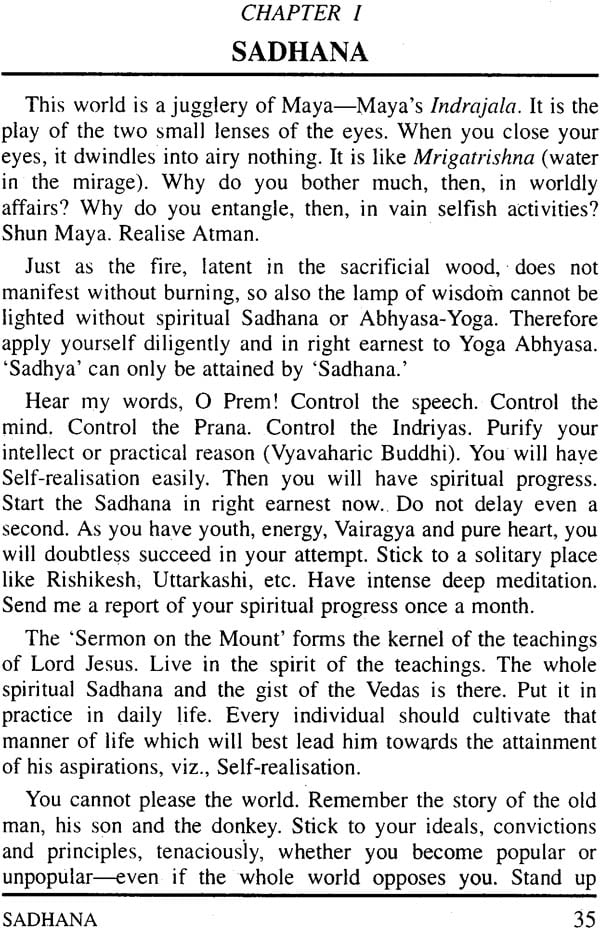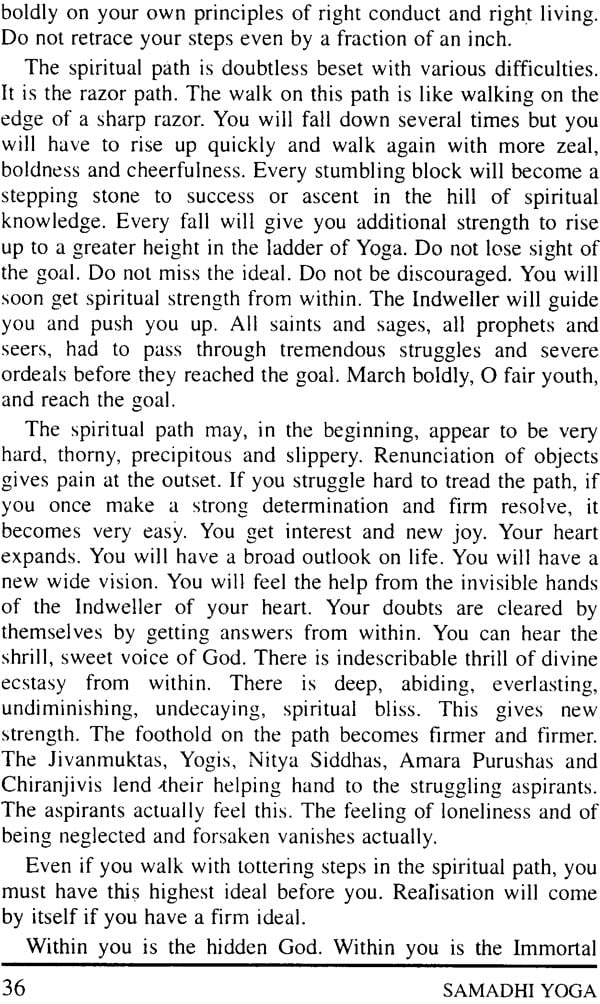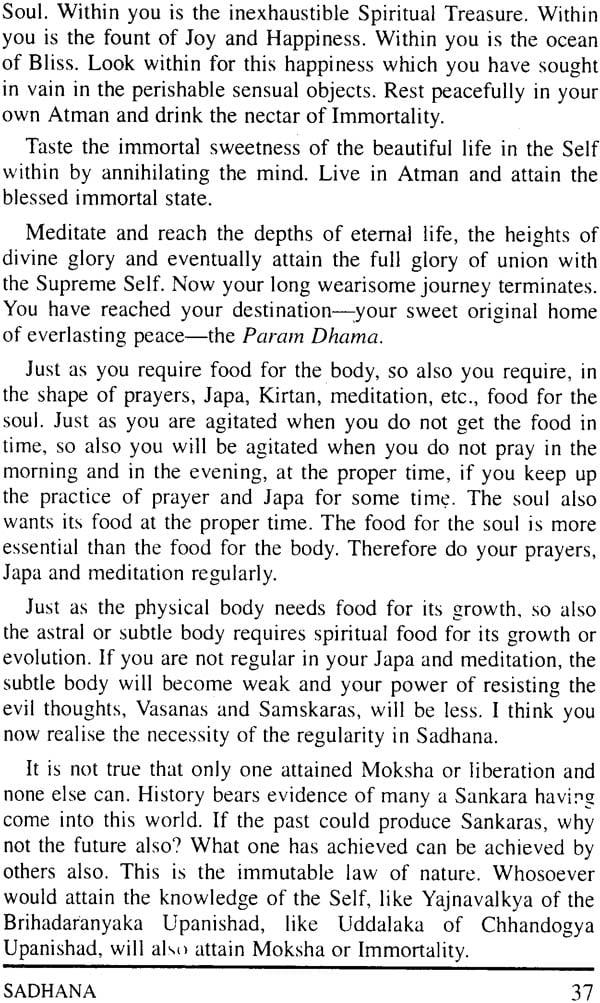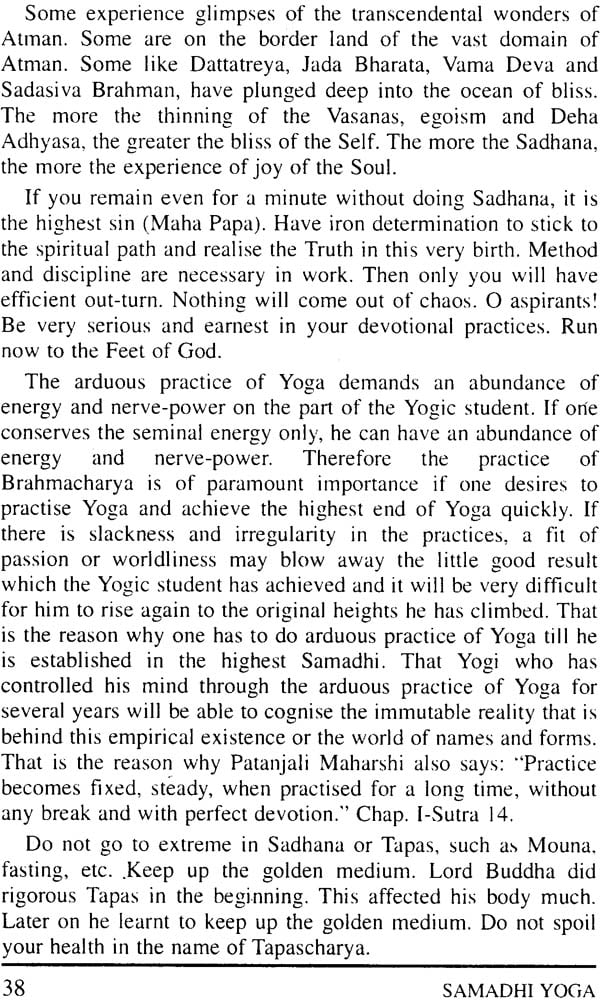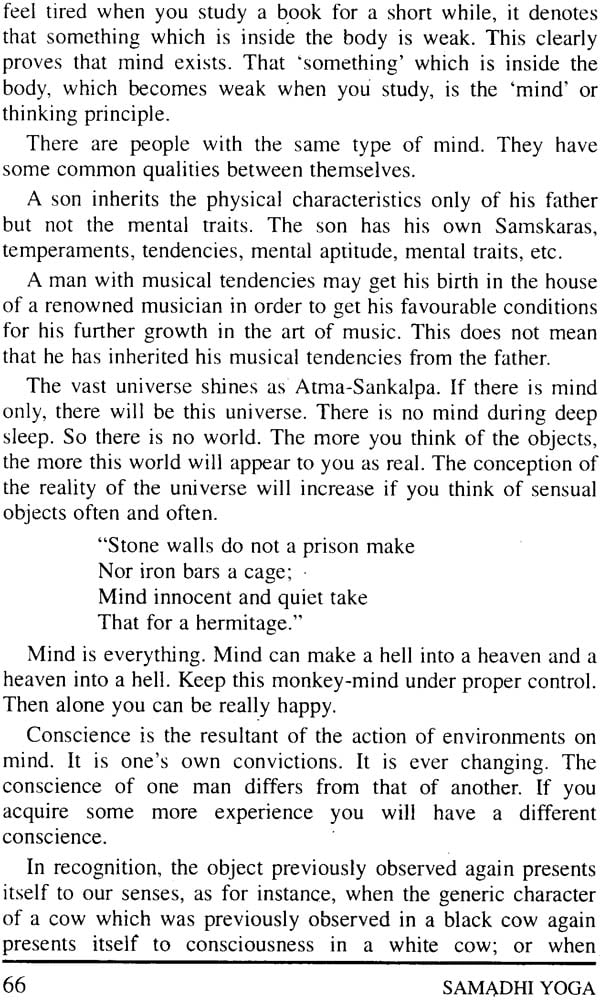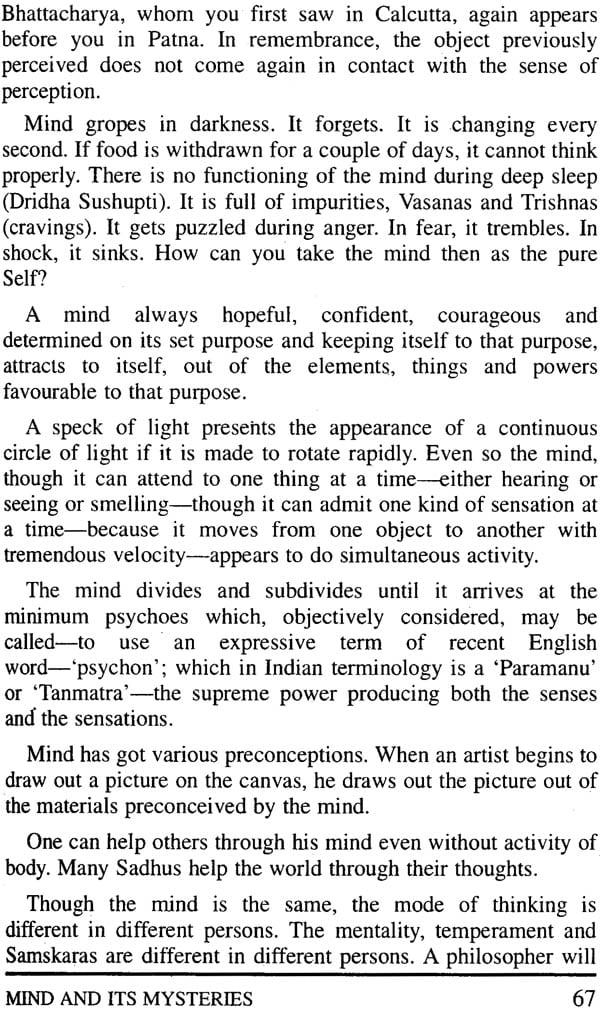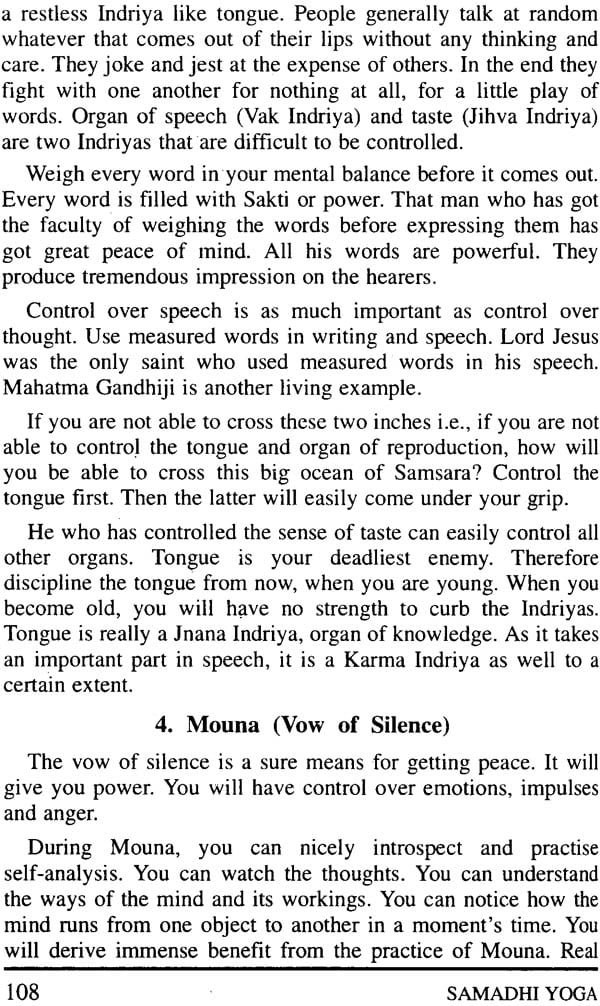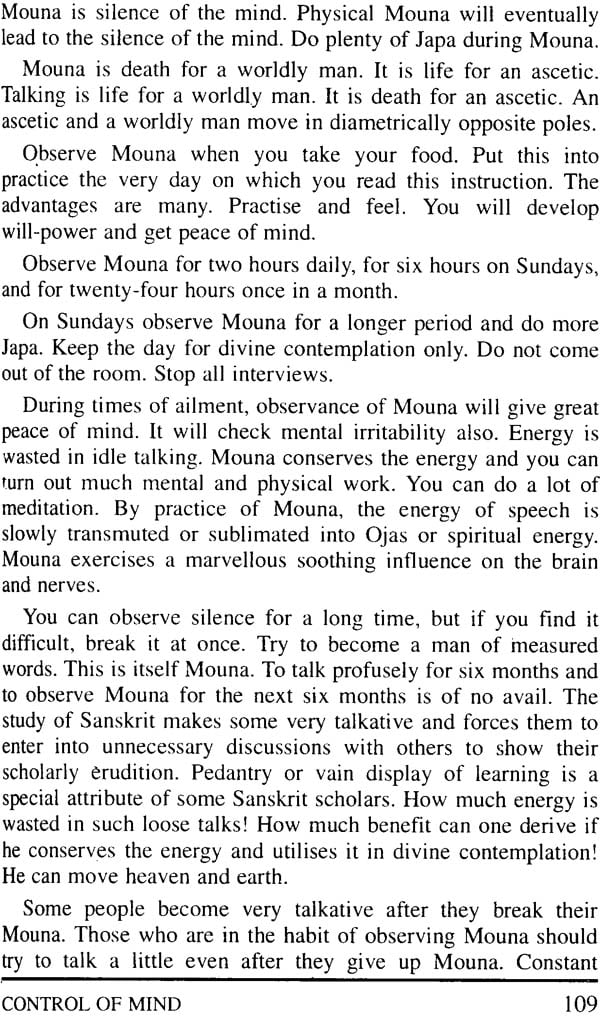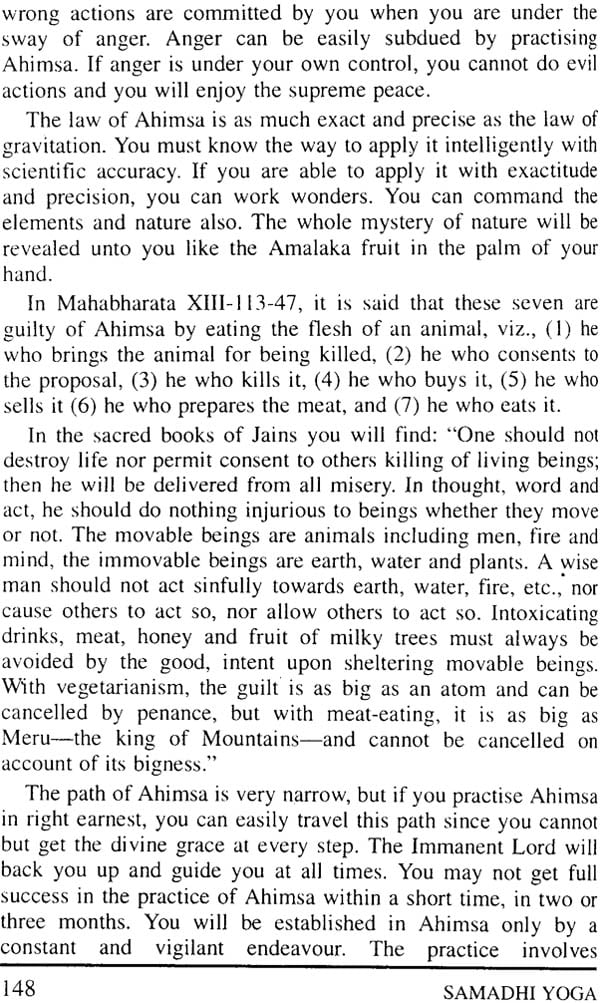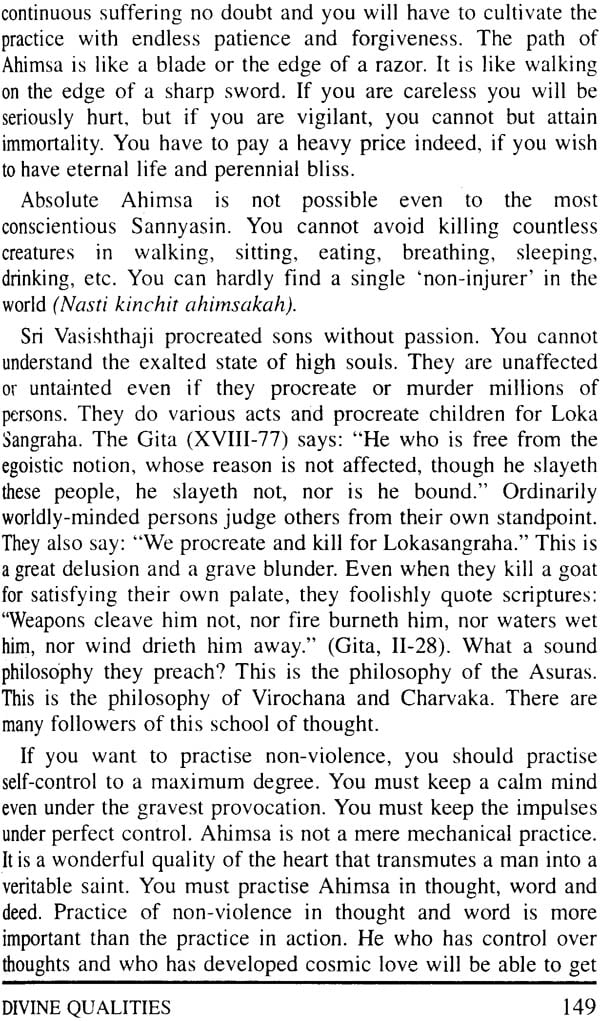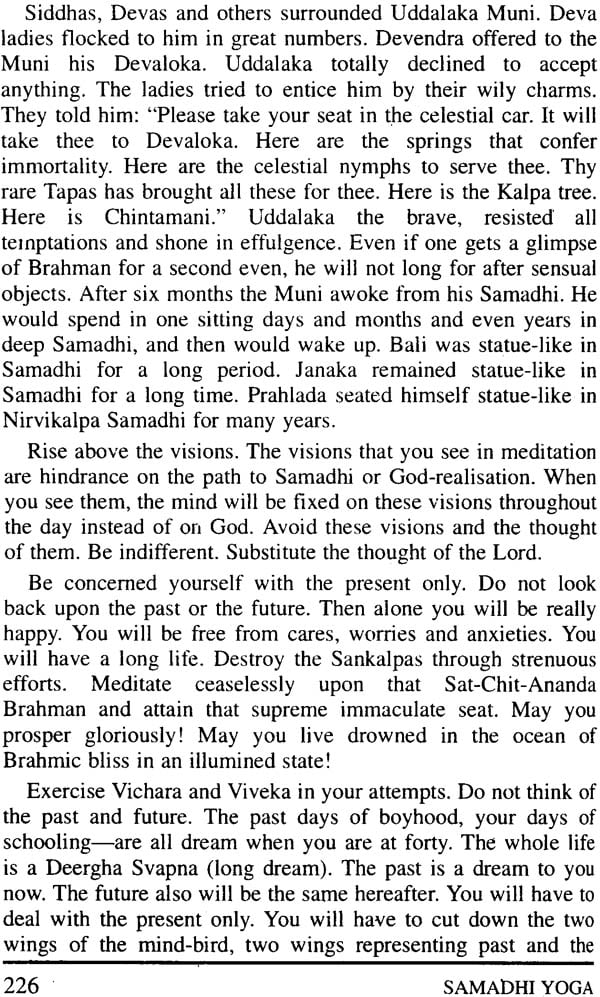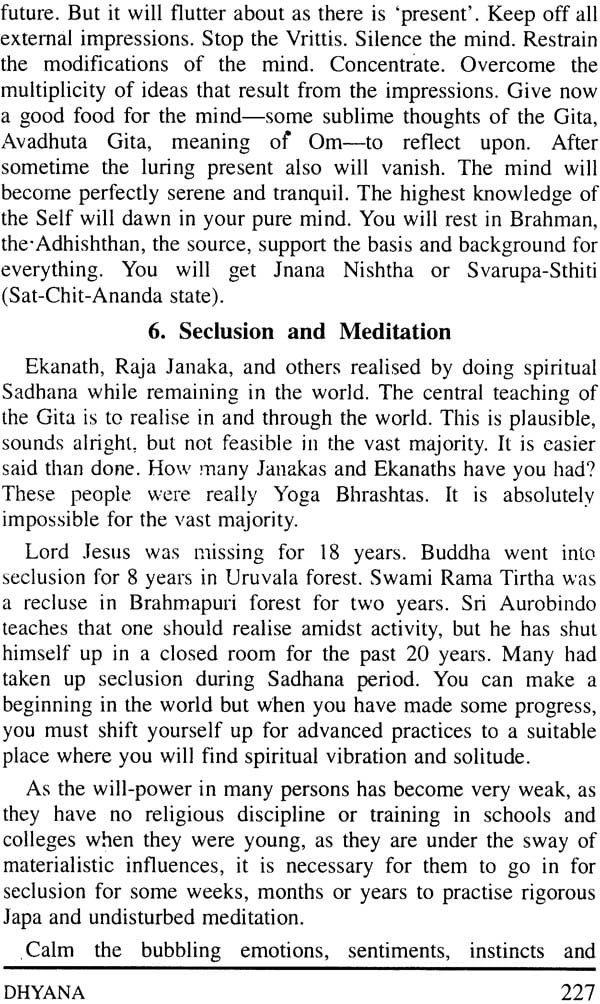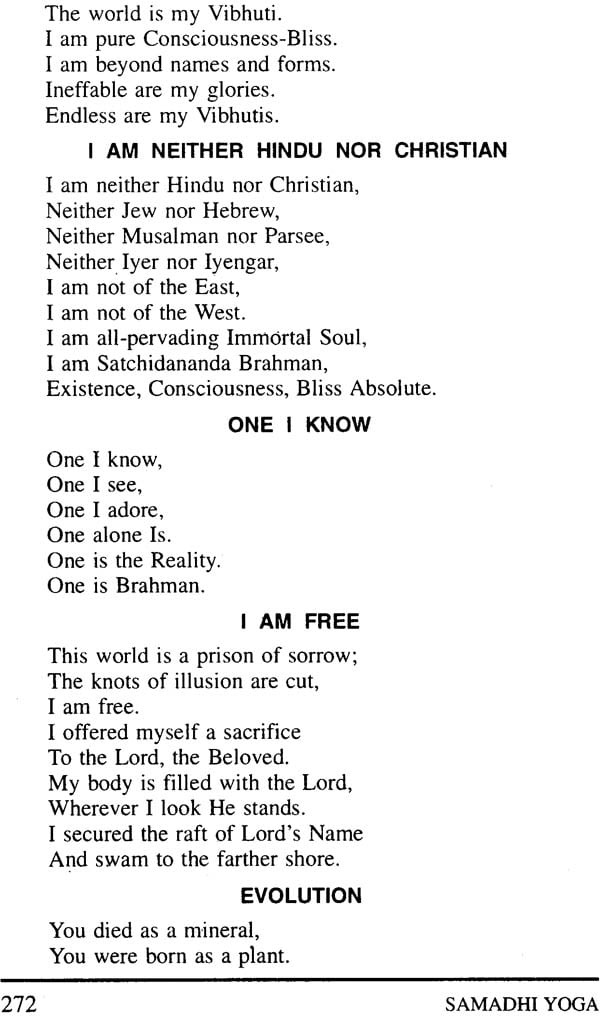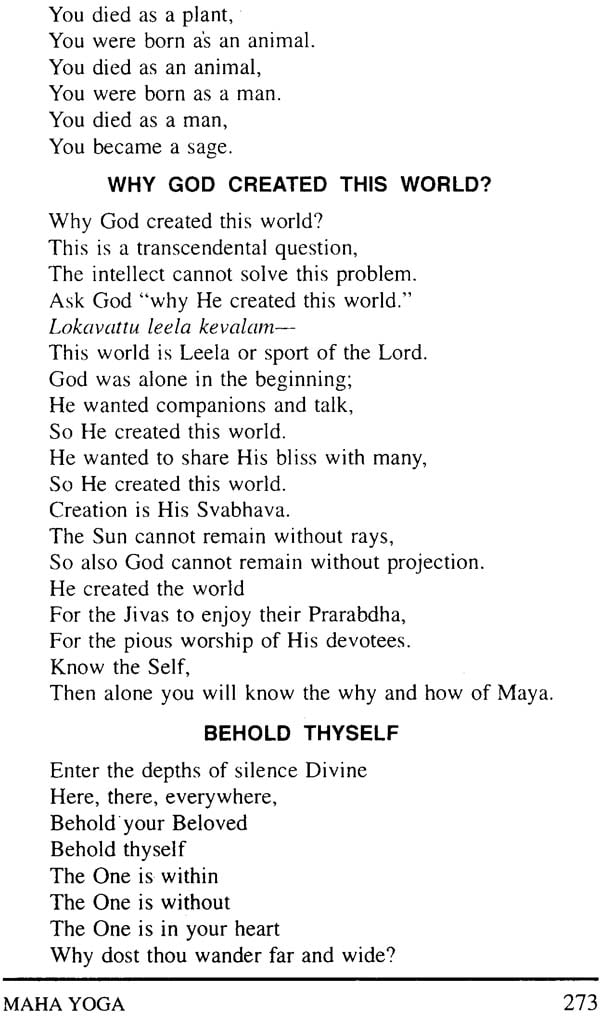
SAMADHI YOGA
Book Specification
| Item Code: | IDG070 |
| Author: | Swami Sivananda |
| Publisher: | THE DIVINE LIFE SOCIETY |
| Language: | English |
| Edition: | 2019 |
| ISBN: | 8170521564 |
| Pages: | 344 |
| Cover: | Paperback |
| Other Details | 8.5 inch X 5.5 inch |
| Weight | 330 gm |
Book Description
About the Author:
Born on the 8th September, 1887, in the illustrious family of Saga Appayya Diskhita and several other renowned saints and savants, Sri Swami Sivananda had a natural flair for a life devoted to the study and practice of Vedanta. Added to this was an inborn eagerness to serve all and an innate feeling of unity with all mankind. His passion for service drew him to the medical career; and soon he gravitated to where he thought that his service was most needed. Malaya claimed him. He had earlier been editing a Health Journal and wrote extensively on health problems. He discovered that people needed right knowledge most of all; dissemination of that knowledge he espoused as his own mission. It was divine dispensation and the blessing of God upon mankind that the doctor of body and mind renounced his career and took to a life of renunciation to qualify himself for ministering to the soul of man. He settled down at Rishikesh in 1924, practiced intense austerities and shone as a great Yogi, Saint, Sage and Jivanmukta. In 1932 he started the Sivanandashram. In 1936 was born The Divine Life Society. In 1948 the Yoga-Vedanta Forest Academy was organized. Dissemination of spiritual knowledge and training of people in Yoga and Vedanta were their aim and object. In 1950 he undertook a lightning tour of India and Ceylon. In 1953 he convened a 'World Parliament Reliogions'. He is the author of over 300 volumes and has disciples all over the world, belonging to all nationalities, religions and creeds. To read his works is to drink at the fountain of Wisdom Supreme. On 14th July, 1963 he entered Mahasamadhi.
Publishers' Note:
It was in the year 1934 that a small pamphlet "Samadhi in Six Months" was written by Sri Swamiji Maharaj and printed and published at Madras. This booklet had a very warm reception and many enquiries poured in for a deeper understanding of the Ancient Secret contained in the Yoga Sastras. The subject was however touched upon in most of the later writings of the Swamiji, but still the revered author cherished a desire to bring out a profounder work on this subject. This work is thus the direct outcome of such a Sankalpa, and its appeal should be far-reaching in giving such Sadhakas, as are fit to enter the portals of the Blissful Union, many direct hints and instructions on practical experiences, and point out the way to the desired illumination.
In placing this book before all thirsty aspirants and seekers of Samadhi, we feel that a thorough understanding of the subject, after a perusal of the other writings of the Swamiji along with sincere spiritual practices and with the grace of the Guru and God, will surely lead them to the summum bonumof existence.---THE DIVINE LIFE SOCIETY
Mind and breath are like milk and water. Raja Yoga is control of mind. He who wants to become a perfect Yogi and to experience the wonderful Samadhi must control mind and breath. He must continuously practise Yoga and observe the rules. He must thoroughly overcome the five Tattvas.
Restraint of the mind (Nirodha) leads to Jnana. Nirodha is the culmination of Sankhya and Yoga. It is Nirodha which underlies all the Sadhanas or spiritual exercises. Restraint of the mind is the essence of all worship. This is Jnana and Dhyana. The highest end is attained by restraint of the mind. The mind should be completely restrained from the objects. The mind should be restrained till it attains dissolution in the heart.
Atman or Brahman is your immortal Self. It is the only blazing reality. If you know this Atman only you can attain perfection. Perfection can be yours in this very life. Atman is to be recognised, to be known as your innermost being through Samadhi. If you know this Atman, which is the Ultimate Reality, which is Perfection, then only your life becomes useful and real existence. The knower of the Atman, the inner perfection, crosses all sorrows and becomes free. If you do not know this Atman, then there is great loss for you.
Samadhi is not a mere emotional enthusiasm or an exhilaration of feeling. It is the direct unique intuitive experience of Truth or Absolute Consciousness or the Ultimate Reality. It is beyond all feeling, throbbing and thrill. There is perfect awareness in Samadhi which is beyond expression and feeling. The aspirant rests in his centre now-the goal of his search and realises the absolute freedom, independence and perfection.
Just as a man who anxiously seeks the means of escape from the midst of a burning house, so also the aspirant should have a burning desire to free himself from the fire of Samsara. Then only he will be able to enter into deep meditation and Samadhi.
The mind becomes the very Brahman, when it is purified and brought into Samadhi state. In Samadhi there is no perception of duality, which is the cause for fear. Avidya is absent in Samadhi.
Samadhi installs you in the Atman. Through Samadhi the finite self is absorbed in the Infinite or Absolute Consciousness. In Samadhi there is no mental tension. There is perfect stillness or perfect poise. There is total mental inhibition. Samadhi follows meditation. Deep meditation is Samadhi. The mind that is endowed with a finished discipline in intensive contemplation can enter into Nirvikalpa Samadhi.
In Samadhi the mind withdraws from its natural or habitual occupation and gets itself fixed upon the Atman which is not touched by the mind. The mind does not at all function in Samadhi. It gets absorbed in Brahman. If you can consciously induce a state like deep sleep, it is no longer deep sleep, but it is Samadhi. It is sleepless sleep wherein the senses and the mind entirely cease their functioning, and the veil of ignorance is destroyed by the fire of knowledge. The aspirant enjoys perfect joy of freedom and infinite, supra-cosmic, vast experiences and the supreme silence of the Imperishable.
In Samadhi the purified mind withdraws itself from the external objects, looks within and concentrates on the Innermost Self or the Atman. It resolves itself in the Atman, its source, and becomes Atman itself. It takes the form of Atman, just as camphor becomes the fire itself. Knowledge of Brahman or Atman is real experience and not mere knowing. To know Brahman is to• become Brahman "Brahmavid Brahmaiva bhavati"-this is the emphatic declaration of the Upanishads.
In Samadhi there is revelation or insight or intuition. The Jnana Chakshus or Divya Chakshus is opened. The third eye of wisdom opens by itself when the Brahmakara Vritti is raised.
The sage born of Samadhi-experience gets established in his own Self. He is endowed with cosmic vision and transcendental divine knowledge.
As long as you are in Samadhi Nishtha there is only Brahman or the Absolute. Nirantara Samadhi does not mean sitting blind-folded but the renunciation of attachment to the body and regarding individual soul and supreme Soul as one and knowing that the practitioner himself is Paramatman and acting upon this knowledge. Samadhi means the annihilation or absorption of the mind. Wherever he goes, he beholds the one Self everywhere. Neither self-abnegation nor Self-knowledge is enough but the co-existence of both self-abnegation and Self-knowledge constitutes Nirantara Samadhi. Self-knowledge is Brahma-Nishtha. He who has acquired this has no body.
The state in which the mind remains free from sensations is Mukti. Vishaya means the function of the senses. Therefore the state of the mind remaining unconnected with the senses or with the mind's own functions or actions, viz., hopes, fears, etc., is Mukti. Mind without mingling with Brahman cannot be disconnected with sensations. Mind becomes one with Brahman. This is Mukti. This is the state of Nirvishaya.
Individual soul becomes Supreme Soul. This is Mukti. Just as salt mingled with water becomes water, so mind mingled with Brahman ultimately becomes Brahman Itself. When the mind becomes Brahman, this world which is the creation of the mind also melts away in Brahman and becomes Brahman Itself. Therefore, All this is Brahman will come home only to him who has practised this Nishtha.
According to Vedanta, annihilation of Avidya or ignorance leads to Samadhi. According to Patanjali Rishi, the aspirant attains Samadhi by removing the hold of Prakriti by practice and discipline.
The Vedanti enjoys the' eternal bliss and natural easiness of Sahaja Samadhi. He remains as a Sakshi or silent witness. He does not make any serious attempt to control the psychic stream or thought-current. He raises the Brahmakara Vritti by meditating on the significance of "Tat Tvam Asi" Mahavakya.
The Chitta is modified in the form of Brahmakara Vritti. All other modifications are withdrawn. This Vritti annihilates the ignorance and dies by itself and Brahman shines out as the aspirant realises his identity. When the Vritti is continuous, the highest form of Samadhi, i.e., Nirvikalpa Samadhi is attained. When it is intermittent, the sage attains Savikalpa Samadhi.
The Samadhi in the Jnani is effortless and spontaneous. "Yatra yatra mano yaati tatra tatra samadhayah "-wherever the mind goes, there it experiences Samadhi. He rests in Samadhi always. There is no 'In Samadhi' and 'Out of Samadhi' for a sage. He experiences Samadhi always without any effort. Hence it is called Sahajavastha or Sahaja Samadhi. He enjoys freedom, bliss and peace, in all moments of his life. He drinks the nectar of immortality in this very life.
Yogic Samadhi is analytical and discriminative. In this Samadhi greater stress is laid upon the discrimination between the Prakriti and the Purusha. In Jnana Samadhi, no discrimination is needed. Brahmakara Vritti, raised by an attempt to become identical with the Supreme Self or Brahma Chintana, destroys Avidya and dies by itself.
Be courageous friends! You will come across various obstacles when you endeavour to control the mind and enter into Samadhi. You will have to conquer Laya (mental inactivity), Vikshepa (distractions), Kashaya (passion) and Sukharaga (taste for pleasure).
Laya or mental inactivity is a state which is equivalent to deep sleep. This is as much a source of evil as passion.
Wake up the mind in Laya. Even though you have conquered over Laya and distraction by repeated practice, by Vairagya, and Jnanabhyasa or Brahma Chintana, yet the mind will not enter into a state of perfect balance or serenity. It will be in an intermediate stage. The mind is still not freed from Raga or attachment which is the seed of all its activity in the direction of external objects. There is still lurking passion or hidden Yasanas or Kashaya. You will have to restrain the mind again and again by Vichara and do rigorous meditation and practice of Samprajnata or Savikalpa Samadhi. Finally you must rest yourself in Asamprajnata or seedless Samadhi (Nirbija Samadhi).
You are not able to enter into Samadhi, because you are not able to practise meditation. You are not able to do profound meditation, because you are not able to fix the mind steadily or concentrate. You are not able to concentrate properly, because you are not able to practise Pratyahara or the withdrawal of the senses from the objects thoroughly. You are not able to practise Pratyahara thoroughly, because you have not obtained mastery over Asanas and Prana through Pranayama and you are not established in Yama and Niyama, which are the foundation of Yoga.
The aspirant who wants to attain Samadhi should have patience like that of the bird Tittibha which tried to empty the ocean with its beak. Once he makes a firm resolve, gods will come to his help in the same way that Garuda came to the help of Tittibha. Help invariably comes from all beings in a righteous act. Even the monkeys and squirrels helped Rama to rescue Sita. He who is endowed with self-control, courage, prowess, fortitude, patience and perseverance, strength and skill, can achieve anything. You should never give up your attempt even if you face insurmountable difficulties.
Whenever desires trouble you, try to attain Vairagya by looking into the defects of sensual life. Cultivate dispassion or indifference to sensual pleasures. Think that enjoyment produces pain and various troubles and everything is perishable. Withdraw the mind again and again from the objects and fix it on the Immortal Self or the picture of the Lord. When the mind attains a state of equanimity, when it is freed from distraction and Laya, do not disturb it.
You must wean the mind from the pleasure of Savikalpa Samadhi which is called Rasasvada. Rasasvada also is an obstacle. This prevents the aspirant from attaining the Nirvikalpa Samadhi. Some aspirants get false contentment from attaining this happiness and stop their Sadhana. They do not attempt to attain the irvikalpa state.
The Sage Uddalaka was not able to master Samadhi which . leads one into the blissful realm of Reality, because the monkey-mind jumped speedily from one branch to another of sensual objects. He seated himself in Padmasana and uttered Pranava (om) with high sounding intonation. Then he started his meditation.
He forcibly controlled his mind. With great difficulty he separated the senses from the objects. He disassociated himself completely from all external objects. He closed the avenues of the body. He fixed his mind in the heart. His mind was freed from all the Vikshepas. He destroyed all thoughts of objects just as a warrior kills with his sword his foes who rise against him again and again.
He saw before him a radiant light. He dispelled Moha. He passed through the stage of darkness, light, sleep and' Moha. He eventually reached the stage of irvikalpa Samadhi and enjoyed perfect calmness. After six months, he woke from his Samadhi. He would spend in one sitting days, months and even years in deep Samadhi and then wake up.
| Pages | ||
| Publishers' Note | (6) | |
| Introduction | (8) | |
| Samadhi in Six Months | (19) | |
| Samadhi According to the Upanishads | (20) | |
| Spiritual Awakeners | (26) | |
| Onward and Godward | (28) | |
| Chapter I : SADHANA | 35 | |
| Chapter II : YOGA | 49 | |
| 1. What Is Yoga? | 49 | |
| 2. Who Is a Yogi? | 55 | |
| 3. Different Paths in Yoga | 57 | |
| Chapter III : MIND AND ITS MYSTERIES | 60 | |
| 1. Mind and Its Nature | 60 | |
| 2. Power of Thought | 73 | |
| 3. Gunas | 81 | |
| 4. Mind and Food | 83 | |
| 5. Desires - The Cause for Bondage | 85 | |
| Chapter IV : CONTROL OF MIND | 96 | |
| 1. Purification of Mind | 96 | |
| 2. Control of Indriyas | 102 | |
| 3. Tongue (Organ of Speech) | 106 | |
| 4. Mouna (Vow of Silence) | 108 | |
| 5. Conquest of Mind | 110 | |
| Chapter V : EVIL QUALITIES | 118 | |
| 1. Anger | 118 | |
| 2. Fear | 125 | |
| 3. Pride | 126 | |
| 4. Hatred and Jealousy | 128 | |
| 5. How to Eradicate Evil Qualities | 131 | |
| Chapter VI : DIVINE QUALITIES | 144 | |
| 1. Truth | 144 | |
| 2. Ahimsa | 146 | |
| 3. Righteousness | 152 | |
| 4. Courage - Strength | 160 | |
| 5. Humility | 162 | |
| 6. Titiskha | 164 | |
| 7. Contentment | 168 | |
| 8. Love and Mercy | 169 | |
| Chapter VII : PRANAYAMA | 172 | |
| 1. Practice of Pranayama | 172 | |
| 2. Hints on Pranayama | 176 | |
| 3. Special Instructions | 178 | |
| Chapter VIII : PRATYAHARA | 182 | |
| Chapter IX : DHARANA | 185 | |
| Chapter X : DHYANA | 192 | |
| 1. Meditation | 192 | |
| 2. Meditation on Different Paths | 197 | |
| 3. Meditation on Om | 202 | |
| 4. Meditation - Benefits and Experiences | 204 | |
| 5. Obstacles in Meditation | 210 | |
| 6. Seclusion and Meditation | 227 | |
| Chapter XI : SIDDHIS | 233 | |
| 1. Siddhis | 233 | |
| 2. Kundalini Yoga | 239 | |
| Chapter XII : SAMADHI | 242 | |
| 1. Raja Yoga Samadhi | 248 | |
| 2. Bhakti Yoga Samadhi | 254 | |
| 3. Jnana Yoga Samadhi | 255 | |
| 4. Concentration | 258 | |
| MAHA YOGA | 261 | |
| SLEEP AND SAMADHI | 288 | |
| THUS AWAKENS SWAMI SIVANANDA | 302 | |
| Appendix : A STATEMENT ON YOGA | 316 |
